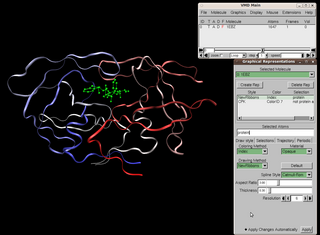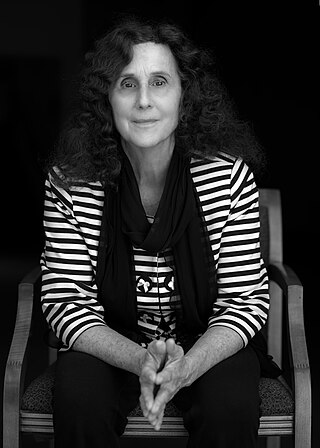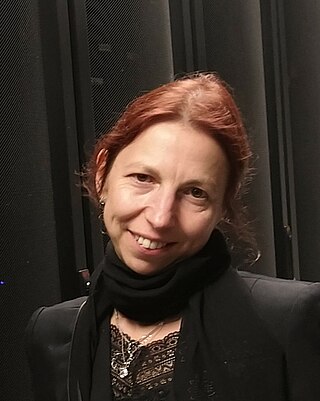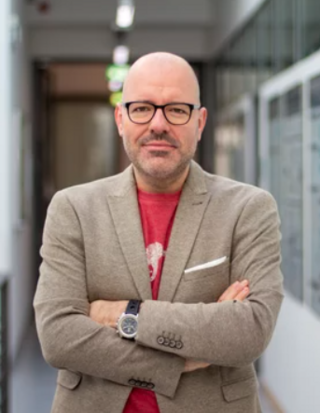Related Research Articles

Structural biology, as defined by the Journal of Structural Biology, deals with structural analysis of living material at every level of organization.

Visual Molecular Dynamics (VMD) is a molecular modelling and visualization computer program. VMD is developed mainly as a tool to view and analyze the results of molecular dynamics simulations. It also includes tools for working with volumetric data, sequence data, and arbitrary graphics objects. Molecular scenes can be exported to external rendering tools such as POV-Ray, RenderMan, Tachyon, Virtual Reality Modeling Language (VRML), and many others. Users can run their own Tcl and Python scripts within VMD as it includes embedded Tcl and Python interpreters. VMD runs on Unix, Apple Mac macOS, and Microsoft Windows. VMD is available to non-commercial users under a distribution-specific license which permits both use of the program and modification of its source code, at no charge.

The Max Planck Institute of Biochemistry is a research institute of the Max Planck Society located in Martinsried, a suburb of Munich. The institute was founded in 1973 by the merger of three formerly independent institutes: the Max Planck Institute of Biochemistry, the Max Planck Institute of Protein and Leather Research, and the Max Planck Institute of Cell Chemistry.

The Max Planck Institute for Biophysical Chemistry, also known as the Karl-Friedrich Bonhoeffer Institute, was a research institute of the Max Planck Society, located in Göttingen, Germany. On January 1, 2022, the institute merged with the Max Planck Institute for Experimental Medicine in Göttingen to form the Max Planck Institute for Multidisciplinary Sciences.

Cryogenic electron tomography (cryoET) is an imaging technique used to reconstruct high-resolution (~1–4 nm) three-dimensional volumes of samples, often biological macromolecules and cells. cryoET is a specialized application of transmission electron cryomicroscopy (CryoTEM) in which samples are imaged as they are tilted, resulting in a series of 2D images that can be combined to produce a 3D reconstruction, similar to a CT scan of the human body. In contrast to other electron tomography techniques, samples are imaged under cryogenic conditions. For cellular material, the structure is immobilized in non-crystalline, vitreous ice, allowing them to be imaged without dehydration or chemical fixation, which would otherwise disrupt or distort biological structures.

Pamela Jane Bjorkman NAS, AAAS is an American biochemist and molecular biologist. She is the David Baltimore Professor of Biology and Biological Engineering at the California Institute of Technology (Caltech). Her research centers on the study of the three-dimensional structures of proteins related to Class I MHC, or Major Histocompatibility Complex, proteins of the immune system, and proteins involved in the immune responses to viruses. Bjorkman's goal is to improve current therapeutic applications. Bjorkman is most well known as a pioneer in the field of structural biology.

Eva Nogales is a Spanish-American biophysicist at the Lawrence Berkeley National Laboratory and a professor at the University of California, Berkeley, where she served as head of the Division of Biochemistry, Biophysics and Structural Biology of the Department of Molecular and Cell Biology (2015–2020). She is a Howard Hughes Medical Institute investigator.

Molecular biophysics is a rapidly evolving interdisciplinary area of research that combines concepts in physics, chemistry, engineering, mathematics and biology. It seeks to understand biomolecular systems and explain biological function in terms of molecular structure, structural organization, and dynamic behaviour at various levels of complexity. This discipline covers topics such as the measurement of molecular forces, molecular associations, allosteric interactions, Brownian motion, and cable theory. Additional areas of study can be found on Outline of Biophysics. The discipline has required development of specialized equipment and procedures capable of imaging and manipulating minute living structures, as well as novel experimental approaches.
James Andrew McCammon is an American physical chemist known for his application of principles and methods from theoretical and computational chemistry to biological systems. A professor at the University of California, San Diego, McCammon's research focuses on the theoretical aspects of biomolecular and cellular activity. In 2011 he was elected to the National Academy of Sciences.

Leucine-rich repeat kinase 2 (LRRK2), also known as dardarin and PARK8, is a large, multifunctional kinase enzyme that in humans is encoded by the LRRK2 gene. LRRK2 is a member of the leucine-rich repeat kinase family. Variants of this gene are associated with an increased risk of Parkinson's disease and Crohn's disease.

The term macromolecular assembly (MA) refers to massive chemical structures such as viruses and non-biologic nanoparticles, cellular organelles and membranes and ribosomes, etc. that are complex mixtures of polypeptide, polynucleotide, polysaccharide or other polymeric macromolecules. They are generally of more than one of these types, and the mixtures are defined spatially, and with regard to their underlying chemical composition and structure. Macromolecules are found in living and nonliving things, and are composed of many hundreds or thousands of atoms held together by covalent bonds; they are often characterized by repeating units. Assemblies of these can likewise be biologic or non-biologic, though the MA term is more commonly applied in biology, and the term supramolecular assembly is more often applied in non-biologic contexts. MAs of macromolecules are held in their defined forms by non-covalent intermolecular interactions, and can be in either non-repeating structures, or in repeating linear, circular, spiral, or other patterns. The process by which MAs are formed has been termed molecular self-assembly, a term especially applied in non-biologic contexts. A wide variety of physical/biophysical, chemical/biochemical, and computational methods exist for the study of MA; given the scale of MAs, efforts to elaborate their composition and structure and discern mechanisms underlying their functions are at the forefront of modern structure science.

Henning Stahlberg is a German physicist and Professor at the Swiss Federal Institute of Technology Lausanne and the University of Lausanne, Switzerland.
Klaus Schulten was a German-American computational biophysicist and the Swanlund Professor of Physics at the University of Illinois at Urbana-Champaign. Schulten used supercomputing techniques to apply theoretical physics to the fields of biomedicine and bioengineering and dynamically model living systems. His mathematical, theoretical, and technological innovations led to key discoveries about the motion of biological cells, sensory processes in vision, animal navigation, light energy harvesting in photosynthesis, and learning in neural networks.

Cryogenic electron microscopy (cryo-EM) is a cryomicroscopy technique applied on samples cooled to cryogenic temperatures. For biological specimens, the structure is preserved by embedding in an environment of vitreous ice. An aqueous sample solution is applied to a grid-mesh and plunge-frozen in liquid ethane or a mixture of liquid ethane and propane. While development of the technique began in the 1970s, recent advances in detector technology and software algorithms have allowed for the determination of biomolecular structures at near-atomic resolution. This has attracted wide attention to the approach as an alternative to X-ray crystallography or NMR spectroscopy for macromolecular structure determination without the need for crystallization.

Erika L F. Holzbaur is an American biologist who is the William Maul Measey Professor of Physiology at University of Pennsylvania Perelman School of Medicine. Her research considers the dynamics of organelle motility along cytoskeleton of cells. She is particularly interested in the molecular mechanisms that underpin neurodegenerative diseases.

Sarah Anne Harris is a British physicist who is an Associate Professor of Biological Physics at the University of Leeds. Her research investigates biomolecular simulations and the topology of DNA. In particular, she makes use of molecular dynamics to explore how DNA responds to stress. She serves as chair of the Engineering and Physical Sciences Research Council (EPSRC) computational collaborative project in Biomolecular simulation.
Susan Mary Lea is a British biologist who serves as chief of the center for structural biology at the National Cancer Institute. Her research investigates host-pathogen interactions and biomolecular pathways. She was elected a Fellow of the Royal Society in 2022.
Olga Vladimirovna Boudker is a Russian born physicist who is a professor of physiology and biophysics at the Weill Cornell Medicine. She looks to understand the mechanisms of membrane transporters in cellular function. She was elected a fellow of the National Academy of Sciences in 2022.

Stefan Raunser is a German scientist and structural biologist specializing in membrane proteins, the cytoskeleton, toxins, and sarcomere structural biochemistry. Since 2014, he has been a director at the Max Planck Institute of Molecular Physiology in Dortmund, Germany.
Julia Mahamid is a cell biologist, structural biologist, and electron microscopist at the European Molecular Biology Laboratory in Heidelberg, Germany, who utilizes biomolecular condensates and advanced cellular cryo-electron tomography to enhance the comprehension of the functional organization of the cytoplasm. She leads the Mahamid Group.
References
- ↑ "STEAM CAREER DAY". muirlandsfoundation. Retrieved 2021-09-27.
- ↑ Villa Rodriguez, Elizabeth; Schulten, Klaus J (2008). Multiscale Modeling of Biomolecular Complexes (Thesis). University of Illinois at Urbana-Champaign. hdl:2142/72397. OCLC 932474791.
- ↑ "Elizabeth Villa – The Villa Lab" . Retrieved 2021-09-27.
- ↑ "Elizabeth Villa". Horizons in Molecular Biology Symposium. Retrieved 2021-09-27.
- ↑ "Pew Awards 22 Promising Biomedical Researchers Funding to Advance Human Health". pew.org. 15 June 2017. Retrieved 2021-09-27.
- ↑ "HHMI Invests $300 Million in 33 New Investigators". HHMI. Retrieved 2021-09-27.
- ↑ "New Nano3 microscope will allow high-resolution look inside cells". EurekAlert!. Retrieved 2021-09-27.
- ↑ "NIH Director's New Innovator Award Program - Award Recipients". commonfund.nih.gov. 2013-06-26. Retrieved 2021-09-27.
- ↑ "Elizabeth Villa Wins Prestigious NIH Grant". physicalsciences.ucsd.edu. Retrieved 2021-09-27.
- ↑ McDonald, Kim; Diego, UC San (2017-11-27). "Women rising". University of California. Retrieved 2021-09-27.
- ↑ "Seminars & Events". molbio.princeton.edu. Retrieved 2021-09-27.
- 1 2 Parton, Robert (2020-08-18). "Faculty Opinions recommendation of The In Situ Structure of Parkinson's Disease-Linked LRRK2". doi: 10.3410/f.738470882.793577642 . S2CID 242227676.
{{cite journal}}: Cite journal requires|journal=(help) - ↑ "Elizabeth Villa, PhD | Parkinson's Disease". www.michaeljfox.org. Retrieved 2021-09-27.
- ↑ "Cellular Mechanism of LRRK2 in Health and Disease | Parkinson's Disease". www.michaeljfox.org. Retrieved 2021-09-27.